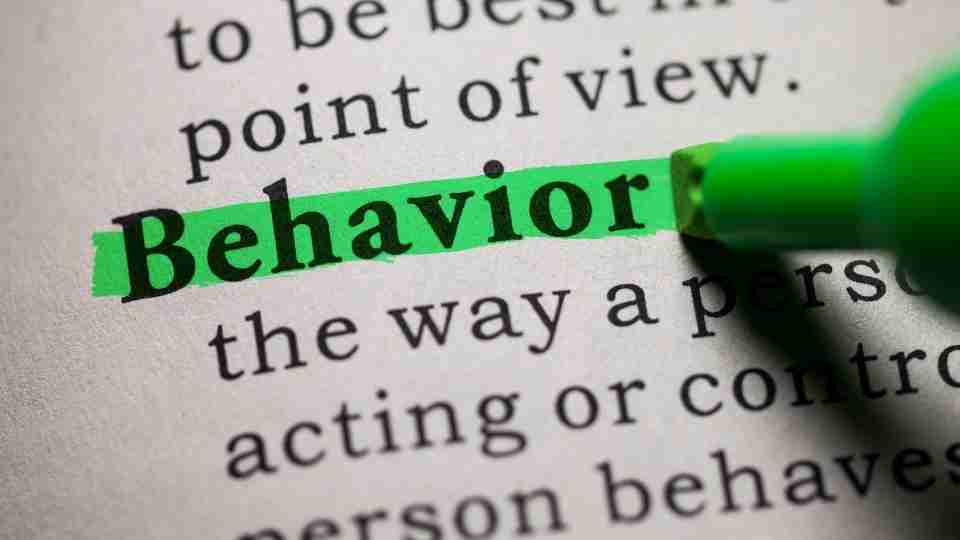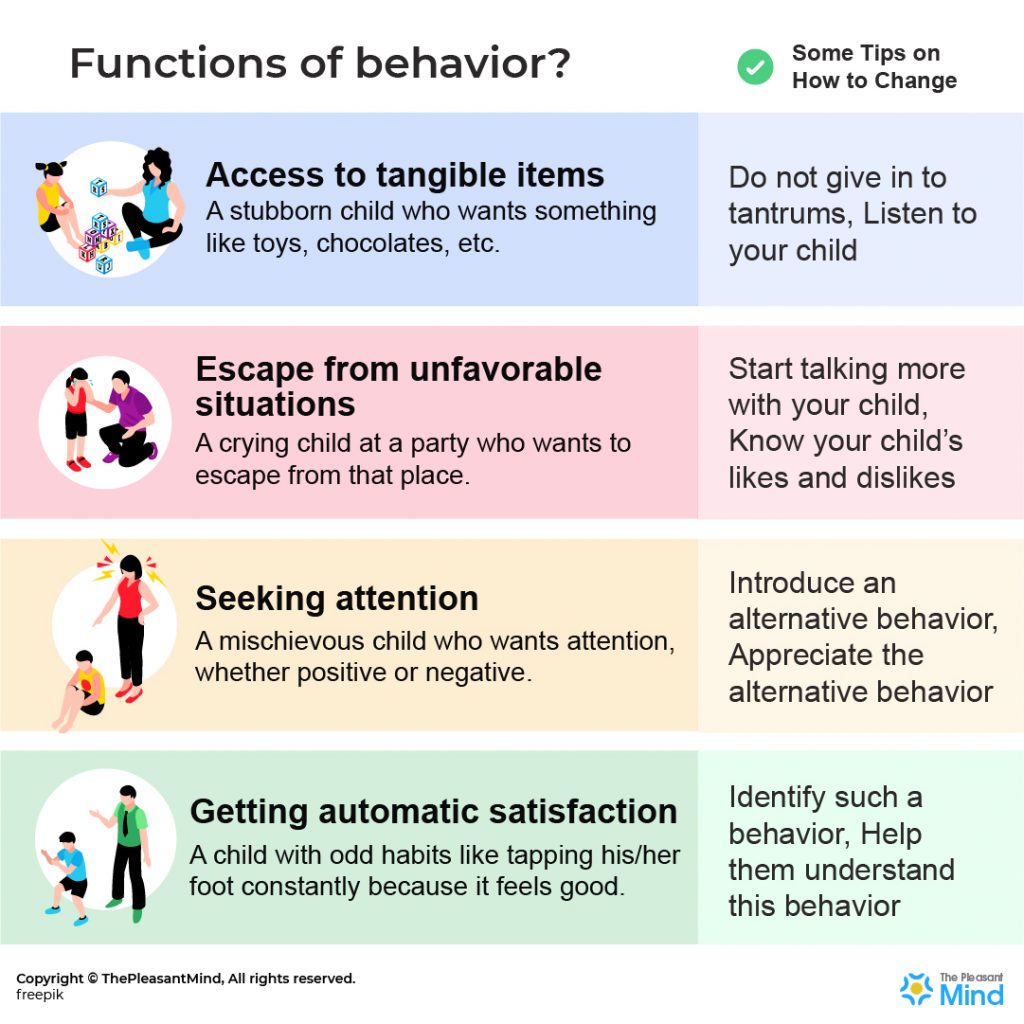
Behavior, as simple as it sounds, is a multi-dimensional part of one’s personality. By definition, it means how you behave in different social and personal settings.
For example, are you shy at parties but outspoken at public forums? Or have you ever noticed a child getting cranky in front of guests but is calm otherwise?
Behavior, whether in an adult or a child, is unique but will always have a function attached to it. Whether it is wanting an object in return or perhaps escaping a situation, functions of behavior will almost always have reward psychology attached to it.
And it all starts at a young age, right from the time we were born.
Functions of Behavior Infographic

What is meant by functions of behavior?
Summary
The functions of behavior refer to all those environmental factors or stimuli that help to understand ‘why’ the behavior is occurring.
The behavior that a person displays always serves a typical purpose for him/her and it also carries a reason for its occurrence.
Sometimes the factors causing the behavior are some external stimulus and in other instances, it could be some internal factors causing the occurrence of the behavior.
It might be difficult to ascertain why a person does something without understanding the function governing such behavior. It has also been found that the same behavior can serve two functions at the same time.
For example, there is a child who throws tantrums at the dinner table and does not finish the meal. This particular behavior serves two purposes for the child.
- He/she can avoid or escape having food that does not meet the preferences. The food appears less tasty and appealing to them.
- To seek or obtain attention from the parents
4 Functions of Behavior
Understanding a newborn baby crying may be simple, but that of a special needs child with autism may get challenging. Studying why an autistic child behaves in a certain way is what we call Applied Behavior Analysis (ABA).
It lists down the four major functions of any and how one can combat it for the betterment of their child. Now, every child’s behavior is as unique as they are but their ‘why’ has some well-distinguished reasons for it.
So, let’s start by identifying this different behavior and a purpose:
Function of Behavior #1 – Access to Tangible Items

SUMMARY
When a child throws a fit in a supermarket because they “absolutely need to have” a toy is a functional behavior where the desire to have something surpasses logic and manner.
A common behavioral function is the desire to have a certain materialistic object. If a child is constantly crying in public because he/she wants the toy train but you, the parent said no.
Now, what happens is creating a ruckus at home is different from that in a public setting. You, as an adult, may want to manage the situation as quietly as possible but the child won’t give in.
If you let the child cry, onlookers may think you’re heartless, and if you scold, you’re harsh. So, you end up buying their preferred item. Now, children catch up with this reaction quickly. And before you know it, there is a pattern.
How to change this behavioral pattern from demanding a thing to asking for it?
Whenever we child is agitated and learns how easy it is to get things out of his/her parent, a pattern starts building. This behavioral function should be replaced by teaching them how to ask nicely.
Giving your child what he/she wants is not entirely wrong but the approach of deriving it is when you should observe and take action.
Here are some pointers that you can start building on as a replacement behavior:
(i) Do not give in to tantrums-
You must stop the immediate scream-and-present method. In this sense, you may not feel good publicly or embarrassed at first but it is important to resist since it’s an essential building block for a child.
(ii) Communicate an alternative way of asking-
Instead of throwing a tantrum, you can tell your child alternative ways to get what he/she wants. The simplest form is communicating nicely. For example, tell them to finish their homework, and then they can get that toy.
(iii) Listen to your child-
As adults, sometimes you may overlook the importance of listening to what your child is saying.
Children are extra-sensitive, so, you must create an environment at home and a bond in general where they feel free to talk and make you understand their needs in a better way.
Function of Behavior #2 – Escape from Unfavorable Situations

SUMMARY
When a child starts acting stubbornly in situations that he/she doesn’t like, it is a functional behavior of escapism.
This is the behavior when a child behaves in a certain way to escape or avoid a situation. For example, a child acting stubborn at a party, crying in a restaurant, or breaking plates or cups at a get-together.
As a parent, you should start taking notice if this becomes a repeated habit. Even though children can be unreasonable at times, this behavior is also common among adults.
When you get an unplanned business call, a friend calling in sick before a reunion, office emergency before a vacation, etc. are all examples when you want to escape situations.
This behavior is thus so common because everybody has people or situations that they don’t like and want to avoid at any cost.
While adults can be rationalized about this behavior, for children, however, one must try to understand why they are behaving this way during specific times and not otherwise. This is when you should take action to try to fix it.
How to change this problem behavior of escaping situations to facing it?
First things first, you should build a relationship with your child that allows him/her to be able to talk freely with you.
If a child is behaving irrationally, especially during social interaction, it may mean that he/she is unable to tell you what is bothering them.
The alternative to this is an escaping behavior. This is why it is encouraged to form a communication between you and your child at an early age.
Here are some ways to start dealing with a child having escaping behavior:
(i) Start talking more often with your child-
If you build a relationship where you and your child talk to each other regularly, it won’t be difficult for him/her to tell you what is bothering them.
Everybody feels uncomfortable at certain times, but if your child can tell you that properly, you may be able to look for an alternative solution to it.
(i) Know your child’s likes and dislikes-
Now, while finding a solution when an escaping behavior occurs may take time, as a parent, you should at least be aware of your child’s general likes and dislikes.
This means if an activity is not liked by your child, you should ask and try to understand their reasons.
Initially, you could let them avoid it but gradually start finding a replacement behavior for the future.
(ii) Introduce a replacement behavior-
Now that you know your child better, think of ways to help them deal with their problems in life. For example, a student refusing to do his/her assignment can instead be shifted to another area or room for some time; this may calm them down and gradually, they’ll finish their work.
If a child wants a toy, teach them to ask nicely, and over time this becomes a habit.
TIP
Remember, communication is key to any form of replacement behavior.
Function of Behavior #3 – Seeking Attention

SUMMARY
When a child is asking for attention not by telling but by behaving erratically, it is a functional behavior where their need to be acknowledged is the main need.
Everybody loves attention or at least some form of it. Whether it’s being in the center stage or giving an opinion, everybody craves for it. In that sense, it’s like sensory stimulation.
The happy hormones in your brain are released and its effect is at the least, pleasurable. In this theory, it does sound fine, so why can it be a problem in children?
Attention seeking is different from getting attention. When a child works hard, for example for a test or competition, and he/she is appreciated, this is where the child has earned the attention of him/her.
But if the child is misbehaving to which you scold them, this is where the child gets negative reinforcement.
In child psychology, attention is attention-whether it’s positive or negative. Getting any form of attention feels good to them. This is when you must find a replacement behavior to help reduce this satisfaction level slowly and steadily.
How to change this behavior from wanting attention to earning it?
As mentioned earlier, attention in its form is not a bad thing, but an uncontrollable need can cause a problem in the long run. This is because, in the case of a child, it doesn’t matter if the attention is given is positive or negative but as long as it’s attention to them.
Here are some ways how you can deal with such a behavioral function:
(i) Introduce an alternative behavior-
What you can do is introduce new ways that give attention to a child. For example, a notorious child in class who is always joking can be encouraged to share their jokes with all at the end of class. What this does is changes behavior from sneaking and troubling the class to being upfront about it.
(ii) Appreciate the alternative behavior-
When a child is appreciated for alternative behavior, their need to behave mischievously slowly reduces because they feel acknowledged and encouraged.
It’s as simple as if your child is appreciated for his/her sense of humor, then the child won’t feel the need to disrupt the class like before.
Function of Behavior #4 – Getting Automatic Satisfaction

SUMMARY
When a child does something unusual as a habit, as simple as constantly cracking the knuckles, it is a functional behavior that has automatic reinforcement or satisfaction.
Sometimes, certain behaviors give satisfaction without any external involvement. What does that mean? It is when the behavior is pleasing enough in itself for an individual.
For example, twirling hair or even tapping a leg when nervous are different kinds of automatic reinforcement behavior. Here, the function is actually to find ways to cope with any situation and not just the social environment.
Understanding the purpose of this behavior can be layered as it has a lot to do with a developmental disability. For example, feeling nervous before an exam or going to a doctor- a child deals with this type of anxiety in one way or another.
As a parent, what you must look out for is whether these odd habits are injurious to them or not. For example, someone scratching or picking their skin to a level of tearing it is way more harmful than someone just pursing their lips before an interview.
How to change an obsessive behavior or habit to reduce it?
Everybody knows that it is okay to be nervous before an exam or starting something new. But how do you gradually reduce anxiety from extreme to being negligible?
Sometimes, confidence comes with time, like when you’re in a job for many years; at other times, you need to take concrete steps to reduce or maintain behaviors.
Here are some ways to reduce such a behavior:
(i) Identify such behavior-
Out of all the four, this behavior may take time to be noticed as being counterproductive for an individual. As parents, you must keep a watch for such habit-like behaviors forming.
For example, a child rocking its head back and forth can be given attention and time to relax by pointing out to them when it happens.
(ii) Help them understand this behavior-
The nature of such automatic behavior sometimes can blend with one’s personality to the extent that they don’t realize its occurrence.
These are the times when parents or people around should pay extra attention to catch the habit early on and teach a replacement behavior for their betterment.
Functional behavior assessment (FBA)
The functional behavior assessment is an integral part of ABA or applied behavior analysis therapy. It is a method to find out why a child behaves or acts in a specific way in response to specific environmental stimuli.
The premise on which this analysis is done is that every human behavior serves an intent or purpose; whether we are aware of it or not. The process helps to identify target behavior that interferes with the child’s new learning.
It also determines the specific intervention plans to improve the individual’s overall performance.
When to follow the Functional behavior assessment (FBA)?
Usually, FBA is a tool precisely used for children who find it difficult to learn properly in a regular classroom setup. This goes true for kids suffering from either autism or ADHD or any other mental condition that limits his/her ability to learn and function with all other kids in the class.
There is no precise or set rule that tells you when to use FBA, but it is used depending upon the vulnerability of the child. This means serious learning problems and disabilities are dealt with using this technique.
The functional behavior assessment can be incorporated in the child’s IEP (individual education plan), which is a written plan for the course of action to be taken for the child’s overall growth and development.
The plan is an easy step-by-step method that is enriching and places the child in the least restrictive framework for learning.
Steps in Functional behavior assessment
In applied behavior analysis, the term function is used to describe the likely reason or cause of why a problem behavior is occurring. After knowing the reasons, it becomes easier for the behavior therapist to design a program to teach appropriate life skills to the child.
The therapist understands how the behavior impacts the life and living of the child. The functional behavior assessment follows some steps. They are as follows:
1. Identify and define the problem behavior
The first step is to identify and state the problem behavior. Here, the therapist clearly wants to know the actual behavior and the situation that reinforces the behavior. The problem should be clearly stated; it should not be ambiguous.
For example, instead of saying that the child is aggressive and disruptive in the classroom; the parent or teacher can say that the child hits other children, inattentive in regular classroom activities, rips pages from the notebook, verbally abuses other children, picks up unnecessary fights with other children in the class.
In this way, the exact maladaptive behaviors are identified and referred to the therapist.
2. Gather more information
In this step, the ABA therapist tries to gather more information about the problem behavior. They may ask the class teacher, school staff, other kids who may know the child well about the maladaptive behaviors and the context in which they occurred.
The therapist uses probing questions like when or where is the behavior occurring? How often does it occur? What happens to the child just before and after the behavior? The reactions of the classmates and teachers are also noted to understand the functions of behavior.
3. Find the reason
The third step in FBA is to analyze the reason for the problem behavior. It looks into the various factors that support such behavior. This is the time to figure out what the child gets from the behavior.
4. Plan an intervention program
After analyzing the reason for the problem behavior, it’s time for the ABA therapist to plan appropriate treatment and special education programs for the child.
It may include changes in the classroom teaching methodology, changes in the behavior of the teachers and classmates towards the child.
This is done to change the maladaptive student behavior. Here, a behavior intervention plan (BIP) is made to reward the positive behaviors.
Positive reinforcements are introduced to see whether the child responds well to the rewards and slowly gets out of the problematic behaviors.
Examples of functional behaviors
Let us understand the functions of behavior from the two examples given below:
Functional Behaviors Example 1 :
- Anna starts crying and throws temper tantrums while going to school everyday
During the observation of this child, the therapist found that whenever the time for school arrives and Anna’s mother helps her to get ready for school, Anna starts to shout, cries incessantly, and throws tantrums beyond control.
This behavior forces her parents to leave the idea of sending her to school for that day.
Since this has become a regular affair, it became a cause of concern. Anna realized that whenever she starts her daily routine, her parents get busy consoling her. In this case, the function of the behavior is to escape and avoid the unpleasant situation of going to school.
Anna hates going to school and she starts behaving in awkward ways to avoid a threatening or fear-inducing stimulus that is highly unpleasant to her.
The ABA therapist has to identify the reasons for such behavior. What is there in school that Anna dislikes? Is she scared of her teachers or any other thing that is inducing a lot of fear in her?
After analyzing the situation the therapist has to make a plan and make desirable changes in the school environment to help the child learn appropriate coping styles to reduce the fear and start loving school again.
Functional Behaviors Example 2 :
- Simon is an eighth grader boy who is jealous and picks up frequent fights with his friends.
The therapist noticed that Simon is attention-seeking by nature and he comes from a broken family. His parents got separated when he was 7 years old.
He lives with his grandmother and his mother looks after his financial expenses, but hardly comes to meet him. He doesn’t know the whereabouts of his father.
Simon is inattentive in class, is not liked by his fellow classmates and teachers. He is aggressive and picks up fights too often in school. When friends were asked, they spoke badly about him, reported him as abusive, quarrelsome, and hyperactive.
In this case, Simon’s function of the behavior is to seek attention from his fellow friends and other significant adults. Since Simon had a traumatic childhood, he is needy of love, care, and affection.
Thus, his hyperactivity and aggression occurred in order to seek regard and attention from others. He feels that his maladaptive behavior is giving him a sense of power and control. His behavior is unconsciously getting reinforced by his internal state of being.
Parting Words
Every individual, whether a child or an adult, can have different behaviors as per their personality. It is when these behaviors start becoming a dominant part of your daily life is when one needs to reflect on the reasons behind it.
Behavior analysts study these habits to determine their function which ascertains whether it is normal or possibly can create hindrance in your life.
As individuals, one should be careful of forming counterproductive habits, and for parents of children, with disabilities or not, you must be attentive to not let them fall prey to such behaviors.
It is always better to maintain behaviors than to rectify them later on in life. As unique as every individual is, still, the behavior is one thing that may have some concrete reasons and one that can be bettered to better yourself.
Article Sources
1. https://insightstobehavior.com/blog/understand-functions-behavior/
2. https://masteraba.com/functions-of-behavior/
3. https://www.thoughtco.com/the-function-of-behavior-3110363
A Psychologist with a master's degree in Psychology, a former school psychologist, and a teacher by profession Chandrani loves to live life simply and happily. She is an avid reader and a keen observer. Writing has always been a passion for her, since her school days. It helps to de-stress and keeps her mentally agile. Pursuing a career in writing was a chance occurrence when she started to pen down her thoughts and experiences for a few childcare and parenting websites. Her lovable niche includes mental health, parenting, childcare, and self-improvement. She is here to share her thoughts and experiences and enrich the lives of few if not many.